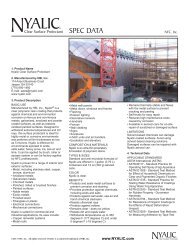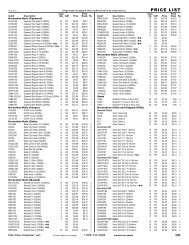Blacksmith Metalsmith Knifemaker Farrier Blacksmith ... - Pieh Tool
Blacksmith Metalsmith Knifemaker Farrier Blacksmith ... - Pieh Tool
Blacksmith Metalsmith Knifemaker Farrier Blacksmith ... - Pieh Tool
You also want an ePaper? Increase the reach of your titles
YUMPU automatically turns print PDFs into web optimized ePapers that Google loves.
BK959<br />
Boone Wrought Iron, Plummer<br />
76 Pages, 8 x 8 (Softcover)<br />
Daniel Boone the 7th has traced his blacksmithing<br />
heritage back 15 generations to 16th century<br />
England. This book is a tribute to his (and Judy’s)<br />
success as a full time professional blacksmith;<br />
this after having a long career as a welder. The<br />
book includes a brief bio, pictures of his shop<br />
and craft fair booth and a discussion on how he approaches the business<br />
of selling ironwork. This is followed by 6 chapters featuring the different<br />
types of ironwork he makes and sells. Along with the pictures there are brief<br />
sidebars which speak to various technical aspects involved in making the<br />
piece. Photographed by Nick Vincent, Edited by Judy Boone. 85 photos.<br />
BK757<br />
Classical Techniques of Hand<br />
Forged Iron, Metzger<br />
72 pages, 8-1/2 x 11 (Softcover)<br />
Translated into English in 2002 by Rudolf Baum.<br />
Franz Kuhn & Francis Whitaker both apprenticed<br />
with Julius Schramm, and were strong<br />
influences in the revival of the Renaissance.<br />
Samuel Yellin also looked to earlier periods, and<br />
worked with the tools, techniques, and traditions<br />
of the Renaissance. Max Metzger saw the future of the blacksmith<br />
in this revival, and he supported the name “Artist-<strong>Blacksmith</strong>” and<br />
describes the techniques and stresses the necessity of freehand<br />
drawing employing old traditions in original work.<br />
BK773<br />
Classic Wrought Ironwork Patterns<br />
and Designs, Small<br />
48 pages, 8-3/8 x 11 (Softcover)<br />
Forty plates of meticulously rendered designs<br />
replicate authentic ironwork projects that span<br />
some 600 years of metalcrafting. Patterns<br />
selected from English churches, chapels, tombs,<br />
castles, and other architectural sites depict<br />
twelfth-century hinges, fifteenth-century grilles and railings,<br />
and seventeenth-century knockers, handles, latches, and other<br />
ornamental elements. Ideal for today’s metal crafters looking to<br />
recreate the decorative architectural accessories from an earlier<br />
era, these royalty-free patterns will also be of value to artists,<br />
architects, and designers. Illustrated.<br />
BK667<br />
Coal Heat, Schuler and Hull<br />
158 pages, 6 x 9 (Softcover)<br />
If you are looking for alternative heat sources from<br />
oil, wood, and electricity this book will tell you all<br />
you need to know about coal heat. Covers types<br />
and availability of coal, maintenance, conversion of<br />
furnaces to coal. Sections are devoted specifically to<br />
the use of coal to heat water, as space heaters and<br />
in fireplaces.<br />
BK250<br />
Complete Modern <strong>Blacksmith</strong>, Weygers<br />
302 pages, 8-1/2 x 11 (Softcover)<br />
This blacksmithing book is a three-in-one of “The<br />
Modern <strong>Blacksmith</strong>”, “The Making of <strong>Tool</strong>s”, and<br />
“The Recycling, Use and Repair of <strong>Tool</strong>s”. This<br />
volume details correct hammer and body motions,<br />
forging, creating tools and a variety of other helpful<br />
advice. Over a thousand detailed line drawings.<br />
BOOKS BLACKSMITHING - TECHNIQUES & PROJECTS<br />
CD795<br />
Complete Working Guide for the<br />
Beginning <strong>Blacksmith</strong> - <strong>Blacksmith</strong>ing<br />
Fundamentals, A, MacKay<br />
192 pages, 8-1/2 x 11 (Softcover)<br />
Heritage blacksmith Don MacKay, was inspired by a<br />
lack of blacksmithing books dedicated to the beginnerwhere<br />
important elements are taken for granted<br />
because they forgot what it was to be a beginner. He stresses the<br />
importance of using sound ageless techniques without the need for<br />
modern tools. Covers the Aspects of <strong>Blacksmith</strong>ing, shop set-up, tools,<br />
building a forge, fuel and design and looks at three shops that predate<br />
the 20th century. Delves into hammer technique, heating principles,<br />
forge welding including a new technique of forge welding: the round<br />
scarf. 21 progressive lessons with photos and articulate descriptive<br />
step-by-step instructions. References, brings together essential<br />
information ranging from forge welding flux recipes from the 1800’s,<br />
tables on metals, etc. Over 100 pictures and diagrams. Also available<br />
on CD, allowing you to print out pages for separate use.<br />
BK212<br />
Decorative and Sculptural Ironwork,<br />
Meilach<br />
312 pages, 8-1/2 x 11 (Softcover)<br />
After a short history of ironwork, Meilach discusses<br />
the iron working shop, forge and tools, including<br />
anvils, vises, hammers, tongs, punches, centrifugal<br />
blowers and machine tools. She presents information<br />
on building, lighting and maintaining a fire. Forging<br />
procedures are explicitly shown: drawing out, flattening, bending,<br />
upsetting, twisting, splitting, punching and drafting, hot cutting on a<br />
hardy, and joining and finishing techniques. 52 color photos and 727<br />
B/W photos and drawings.<br />
BK758<br />
Descriptive Drawing for Metalwork &<br />
Workbook for Descriptive Drawing,<br />
Baum<br />
2 book set: Bk 1: 48 pages,<br />
Bk 2: 76 pages, 8-1/2 x 11 (Spiral Softcover)<br />
Rudolf Baum was head of the metalwork department<br />
at a state technical school in Hennef, Germany. He<br />
prepared these books to provide an introduction to<br />
descriptive drawing for both apprentices and advanced<br />
artist-blacksmiths. <strong>Blacksmith</strong>ing begins with an<br />
idea which then becomes a mental picture. This<br />
must then become a real picture, usually a freehand<br />
drawing, realistic enough so the experienced<br />
smith can present it to his customer, and use it as a<br />
basis for a dimensioned shop drawing. The drawings<br />
in these books appear to be three-dimensional; the objects look as<br />
though they could be picked up. The realistic effect is the result of<br />
simple shading techniques explained in detail in the text, and avoids<br />
the need for an engineers drawing.<br />
BK180<br />
Elementary Forge Practice, Harcourt<br />
128 pages, 4-1/2 x 6-1/2 (Softcover)<br />
This is a series of excellent line drawings<br />
illustrating the techniques and methods of the<br />
metalworker as well as the uses of specialized<br />
tools for each task. Harcourt has focused on the<br />
making of tools as a course of study in the use<br />
of the forge. A modern would-be smith can follow<br />
Harcourt’s course of study and end up with many of the tools he<br />
will need to expand upon what was learned.<br />
<strong>Pieh</strong> <strong>Tool</strong> Company, Inc. 1-888-743-4866 97




